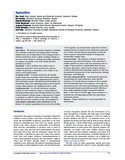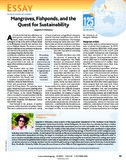Ecological role and services of tropical mangrove ecosystems: A reassessment
- Global styles
- MLA
- Vancouver
- Elsevier - Harvard
- APA
- Help
Share
Abstract
Aim
To reassess the capacity of mangroves for ecosystem services in the light of recent data.
Location
Global mangrove ecosystems.
Methods
We review four long-standing roles of mangroves: (1) carbon dynamics – export or sink; (2) nursery role; (3) shoreline protection; (4) land-building capacity. The origins of pertinent hypotheses, current understanding and gaps in our knowledge are highlighted with reference to biogeographic, geographic and socio-economic influences.
Results
The role of mangroves as C sinks needs to be evaluated for a wide range of biogeographic regions and forest conditions. Mangrove C assimilation may be under-estimated because of flawed methodology and scanty data on key components of C dynamics. Peri-urban mangroves may be manipulated to provide local offsets for C emission. The nursery function of mangroves is not ubiquitous but varies with spatio-temporal accessibility. Connectivity and complementarity of mangroves and adjacent habitats enhance their nursery function through trophic relay and ontogenetic migrations. The effectiveness of mangroves for coastal protection depends on factors at landscape/geomorphic to community scales and local/species scales. Shifts in species due to climate change, forest degradation and loss of habitat connectivity may reduce the protective capacity of mangroves. Early views of mangroves as land builders (especially lateral expansion) were questionable. Evidence now indicates that mangroves, once established, directly influence vertical land development by enhancing sedimentation and/or by direct organic contributions to soil volume (peat formation) in some settings.
Main conclusions
Knowledge of thresholds, spatio-temporal scaling and variability due to geographic, biogeographic and socio-economic settings will improve the management of mangrove ecosystem services. Many drivers respond to global trends in climate change and local changes such as urbanization. While mangroves have traditionally been managed for subsistence, future governance models must involve partnerships between local custodians of mangroves and offsite beneficiaries of the services.
Keywords
Carbon dynamics ecosystem services land building management mangroves nursery function shoreline protectionSuggested Citation
Lee, S. Y., Primavera, J., Dahdouh-Guebas, F., McKee, K., Bosire, J. O., Cannicci, S., Diele, K., Fromard, F., Koedam, N., Marchand, C., Mendelssohn, I., Mukherjee, N., & Record, S. (2014). Ecological role and services of tropical mangrove ecosystems: A reassessment. Global Ecology and Biogeography , 23(7), 726-743. https://doi.org/10.1111/geb.12155
Type
ArticleISSN
1466-822X; 1466-8238Collections
- Journal Articles [1258]
Related items
Showing items related by title, author, creator and subject.
-
Aquaculture
Troell, Max; Kautsky, Nils; Beveridge, Malcolm; Henriksson, Patrik; Primavera, Jurgenne ; Rönnbäck, Patrick; Folke, Carl (Academic Press, 2013)
Biophysical impacts of aquaculture, with consequences for biodiversity, vary with species and culture systems and include issues such as: nutrient enrichment/removal, chemicals, land use, species introductions, genetic ...
; Rönnbäck, Patrick; Folke, Carl (Academic Press, 2013)
Biophysical impacts of aquaculture, with consequences for biodiversity, vary with species and culture systems and include issues such as: nutrient enrichment/removal, chemicals, land use, species introductions, genetic ... -
Retaining our mangrove greenbelt: Integrating mangroves and aquaculture
Although multilateral agencies in Southeast Asia have long been promoting that mangroves, and other wetlands, are wastelands to be put into better use, such as conversion to ponds. However, there is a need for Mangrove ... -
Mangroves, fishponds, and the quest for sustainability
Aquaculture, the farming of shrimp and other useful aquatic and marine plants and animals in artificially confined and tended ponds, pens, and cages, ranks as a phenomenal success story in global food production. In 1975, ...





